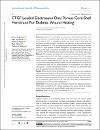CTGF Loaded Electrospun Dual Porous Core-Shell Membrane For Diabetic Wound Healing
| المؤلف | Augustine, Robin |
| المؤلف | Zahid, Alap Ali |
| المؤلف | Hasan, Anwarul |
| المؤلف | Wang, Mian |
| المؤلف | Webster, Thomas J |
| تاريخ الإتاحة | 2020-07-23T19:50:12Z |
| تاريخ النشر | 2019 |
| اسم المنشور | International Journal of Nanomedicine |
| المصدر | Scopus |
| الملخص | Purpose: Impairment of wound healing is a major issue in type-2 diabetes that often causes chronic infections, eventually leading to limb and/or organ amputation. Connective tissue growth factor (CTGF) is a signaling molecule with several roles in tissue repair and regeneration including promoting cell adhesion, cell migration, cell proliferation and angiogenesis. Incorporation of CTGF in a biodegradable core-shell fiber to facilitate its sustained release is a novel approach to promote angiogenesis, cell migration and facilitate wound healing. In this paper, we report the development of CTGF encapsulated electrospun dual porous PLA-PVA core-shell fiber based membranes for diabetic wound healing applications. Methods: The membranes were fabricated by a core-shell electrospinning technique. CTGF was entrapped within the PVA core which was coated by a thin layer of PLA. The developed membranes were characterized by techniques such as Scanning Electron Microscopy (SEM), Fourier Transform Infrared Spectroscopy (FTIR) and X-Ray Diffraction (XRD) analysis. In vitro cell culture studies using fibroblasts, keratinocytes and endothelial cells were performed to understand the effect of CTGF loaded membranes on cell proliferation, cell viability and cell migration. A chicken chorioallantoic membrane (CAM) assay was performed to determine the angiogenic potential of the membranes. Results: Results showed that the developed membranes were highly porous in morphology with secondary pore formation on the surface of individual fibers. In vitro cell culture studies demonstrated that CTGF loaded core-shell membranes improved cell viability, cell proliferation and cell migration. A sustained release of CTGF from the core-shell fibers was observed for an extended time period. Moreover, the CAM assay showed that core-shell membranes incorporated with CTGF can enhance angiogenesis. Conclusion: Owing to the excellent cell proliferation, migration and angiogenic potential of CTGF loaded core-shell PLA-PVA fibrous membranes, they can be used as an excellent wound dressing membrane for treating diabetic wounds and other chronic ulcers. |
| راعي المشروع | This article was made possible by the NPRP9-144-3-021 grant funded by the Qatar National Research Fund (a part of the Qatar Foundation). We also acknowledge the support provided by the Central Laboratories Unit (CLU), Qatar University, Qatar. The statements made herein are solely the responsibility of the authors. The publication of this article was funded by the Qatar National Library. The authors also acknowledge Huseyin Cagatay Yalcin and Ala-Eddin Al Moustafa for sharing resources during the initial stage of this project. |
| اللغة | en |
| الناشر | Dove Medical Press Ltd. |
| الموضوع | CTGF Diabetic wound Electrospinning PLA PVA |
| النوع | Article |
| الصفحات | 8573-8588 |
| رقم المجلد | 14 |
الملفات في هذه التسجيلة
هذه التسجيلة تظهر في المجموعات التالية
-
أبحاث مركز البحوث الحيوية الطبية [764 items ]
-
الهندسة الميكانيكية والصناعية [1454 items ]


